Strength Analysis of a Novel High-Pressure Die with Double-Layered Split Structure
Abstract
:1. Introduction
2. Finite Element Modelling
2.1. Geometric Model
2.2. Material Model
2.3. Numerical Model
3. Results and Discussion
3.1. Stress Analysis of the Cylinder
3.2. Stress on the First Layer Supporting Ring
3.3. Principal Stress Distributions of Cylinder and First Layer Supporting Ring
4. Double-Layered Split Die with Varying Number of Split Blocks
4.1. Stress Analysis of the Cylinders
4.2. Stress Analysis of the First Layer Supporting Rings
4.3. Analysis of Pressure-Bearing Capacity
5. Experiments
6. Conclusions
Author Contributions
Funding
Acknowledgments
Conflicts of Interest
References
- Xu, B.; Tian, Y.J. Superhard materials: Recent research progress and prospects. Sci. China Mater. 2015, 58, 132–142. [Google Scholar] [CrossRef]
- Xu, C.; He, D.W.; Wang, H.K.; Guan, J.W.; Liu, C.M.; Peng, F.; Wang, W.D.; Kou, Z.; He, K.; Yan, X.Z.; et al. Nano-polycrystalline diamond formation under ultra-high pressure. Int. J. Refract. Met. H 2013, 36, 232–237. [Google Scholar] [CrossRef]
- Ichida, Y.; Ohfuji, H.; Irifune, T.; Kunimoto, T.; Kojima, Y.; Shinmei, T. Synthesis of coarse-grain-dispersed nano-polycrystalline cubic boron nitride by direct transformation under ultrahigh pressure. Diam. Relat. Mater. 2017, 77, 25–34. [Google Scholar] [CrossRef]
- Taniguchi, T.; Akaishi, M.; Kanke, Y.; Yamaoka, S. TiC-diamond composite disk-heater cell assembly to generate temperature of 2000 °C in a large-volume belt-type high-pressure apparatus at 10 GPa. Rev. Sci. Instrum. 2004, 75, 1959–1962. [Google Scholar] [CrossRef]
- Liebermann, R.C. Multi-anvil, high pressure apparatus: A half-century of development and progress. High Pressure Res. 2011, 31, 493–532. [Google Scholar] [CrossRef]
- Miyakawa, M.; Taniguchi, T. Homogeneous heating of a sample space by a modified heating assembly in a belt-type high-pressure apparatus. Rev. Sci. Instrum. 2015, 86, 125. [Google Scholar] [CrossRef] [PubMed]
- Fontanari, V.; Bellin, F.; Visintainer, M.; Ischia, G.; Fontanari, V.; Bellin, F.; Visintainer, M. Study of pressure sensitive plastic flow behaviour of gasket materials. Exp. Mech. 2006, 46, 313–323. [Google Scholar] [CrossRef]
- Dobson, D.P.; Mecklenburgh, J.L.; Alfe, D.; Wood, I.G.; Daymond, M.R. A new belt-type apparatus for neutron-based rheological measurements at gigapascal pressures. High Pressure Res. 2005, 25, 107–118. [Google Scholar] [CrossRef]
- Khvostantsev, L.G.; Slesarev, V.N. Large-volume high-pressure devices for physical investigations. Physics-Uspekhi 2008, 51, 1099–1104. [Google Scholar] [CrossRef]
- Liu, Z.W.; Li, M.Z.; Yang, Y.F.; Wang, B.L.; Sui, Z. Study on pressure capacity of multilayer stagger-split die, using simulation-based optimization. High Pressure Res. 2013, 33, 787–794. [Google Scholar] [CrossRef]
- Bocquillon, G.; Léger, J.M.; Bogicevic, C. Optimization of stress in the anvils of an opposed-movement multianvil device. Meas. Sci. Technol. 2002, 13, 885. [Google Scholar] [CrossRef]
- Liu, Z.W.; Li, M.Z.; Han, Q.G.; Yang, Y.F.; Wang, B.L.; Sui, Z. Numerical simulation and experiment on multilayer stagger-split die. Rev. Sci. Instrum. 2013, 84, 165. [Google Scholar] [CrossRef] [PubMed]
- Wang, B.L.; Li, M.Z.; Yang, Y.F.; Liu, Z.W. Note: Double-beveled multilayer stagger-split die for a large volume high-pressure apparatus. Rev. Sci. Instrum. 2015, 86, 165. [Google Scholar] [CrossRef] [PubMed]
- Yang, Y.F.; Li, M.Z.; Liu, Z.W.; Wang, B.L. Numerical simulation and experiment on split tungsten carbide cylinder of high pressure apparatus. Rev. Sci. Instrum. 2015, 86, 29. [Google Scholar] [CrossRef] [PubMed]
- Levitas, V.I.; Zarechnyy, O.M. Modeling and simulation of strain-induced phase transformations under compression and torsion in a rotational diamond anvil cell. Phys. Rev. B 2010, 82, 174123. [Google Scholar] [CrossRef]
- Fang, J.; Bull, C.L.; Loveday, J.S.; Nelmes, R.J.; Kamenev, K.V. Strength analysis and optimisation of double-toroidal anvils for high-pressure research. Rev. Sci. Instrum. 2012, 83, 165. [Google Scholar] [CrossRef] [PubMed]
- Bai, X.; Wu, S.J.; Liaw, P.J.; Shao, L.; Gigax, J. Effect of heavy ion irradiation dosage on the hardness of SA508-IV reactor pressure vessel steel. Metals-Open Access Metall. J. 2017, 7, 25. [Google Scholar] [CrossRef]
- Na, H.S.; Kim, B.H.; Lee, S.H.; Kang, C.Y. Thermodynamic alloy design of high strength and toughness in 300 mm thick pressure vessel wall of 1.25Cr-0.5Mo steel. Metals-Open Access Metall. J. 2018, 8, 70. [Google Scholar] [CrossRef]
- Yao, Y.C. Synthetic Diamond and Ultra-High Pressure High Temperature Technology, 1st ed.; Chemical: Beijing, China, 1996; p. 138. [Google Scholar]
- Han, Q.G.; Li, M.Z.; Jia, X.P.; Ma, H.A.; Li, Y.F. Modeling of effective design of high pressure anvils used for large scale commercial production of gem quality large single crystal diamond. Diam. Relat. Mater. 2011, 20, 969–973. [Google Scholar] [CrossRef]
- Teppernegg, T.; Klünsner, T.; Kremsner, C.; Tritremmel, C.; Czettl, C.; Puchegger, S.; Marsoner, S.; Pippan, R.; Ebner, R. High temperature mechanical properties of WC–Co hard metals. Int. J. Refract. Met. H 2016, 56, 139–144. [Google Scholar] [CrossRef]
- Getting, I.C.; Chen, G.; Brown, J.A. The strength and rheology of commercial tungsten carbide cermets used in high-pressure apparatus. Pure Appl. Geophys. 1993, 141, 545–577. [Google Scholar] [CrossRef]
- Klünsner, T.; Wurster, S.; Supancic, P.; Ebner, R.; Jenko, M.; Glätzle, J.; Püschel, A.; Pippan, R. Effect of specimen size on the tensile strength of WC-Co hard metal. Acta Mater. 2011, 59, 4244–4252. [Google Scholar] [CrossRef]
- Han, Q.G.; Ma, H.A.; Li, R.; Zhou, L.; Tian, Y.; Liang, Z.Z.; Jia, X.P. Finite element analysis of high-pressure anvils according to the principle of lateral support. J. Appl. Phys. 2007, 102, 10. [Google Scholar] [CrossRef]
- Yang, Y.F.; Li, M.Z.; Wang, B.L. Study on stress distribution of tangent split high pressure apparatus and its pressure bearing capacity. Diam. Relat. Mater. 2015, 58, 180–184. [Google Scholar] [CrossRef]
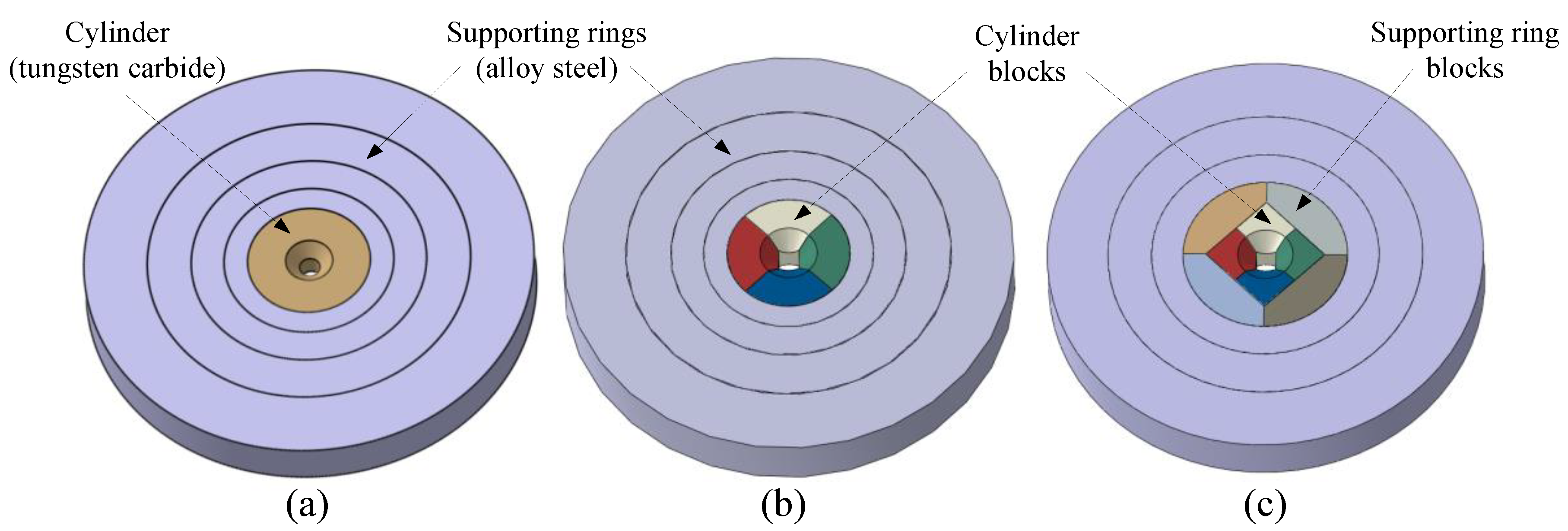
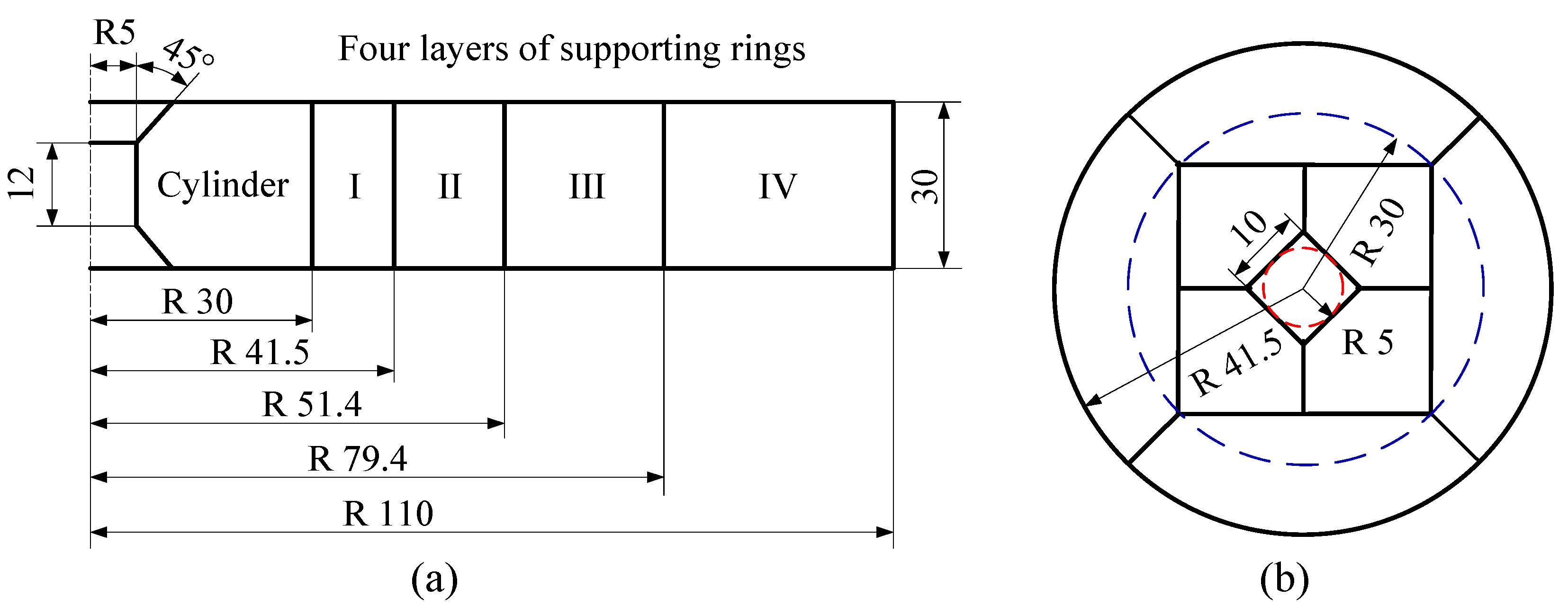
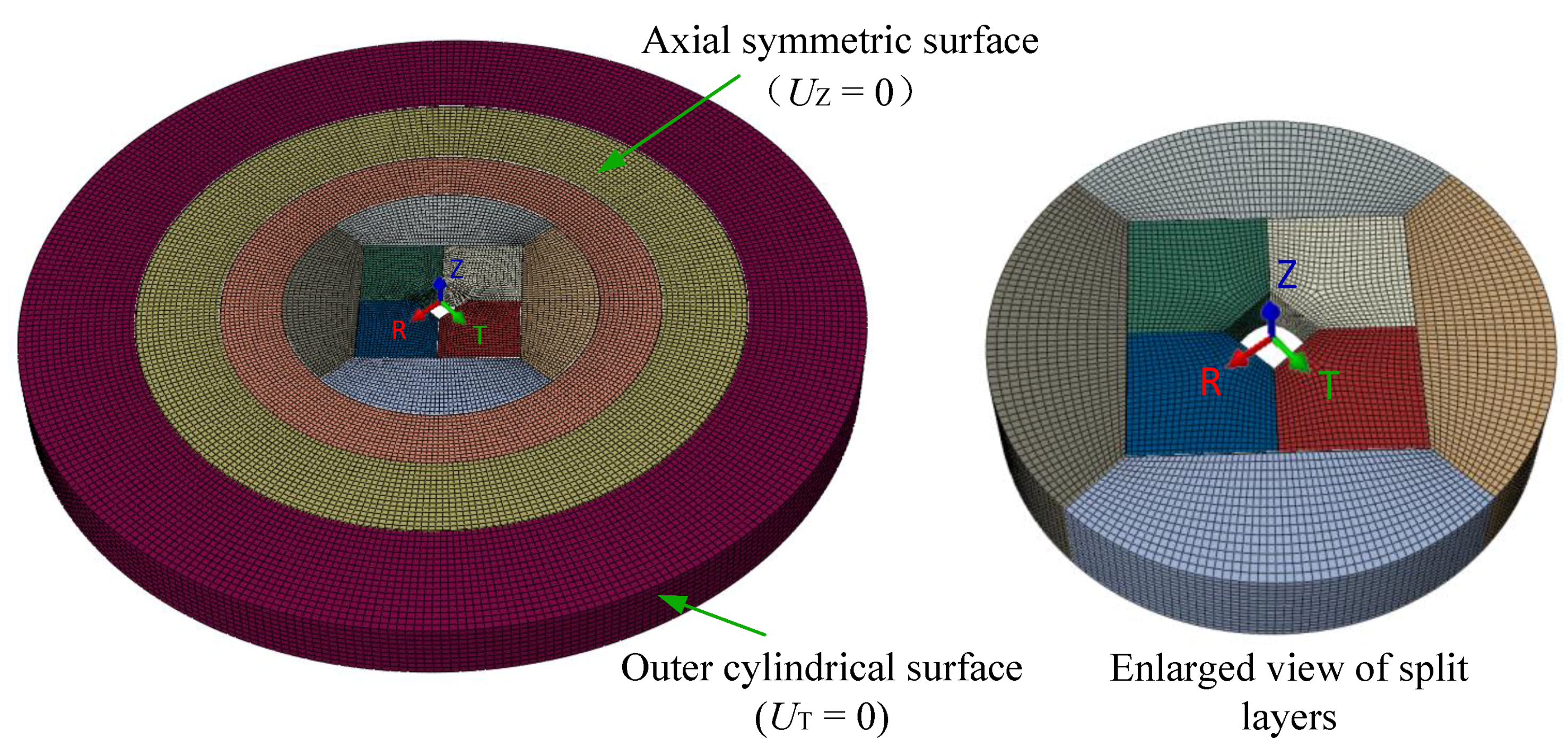



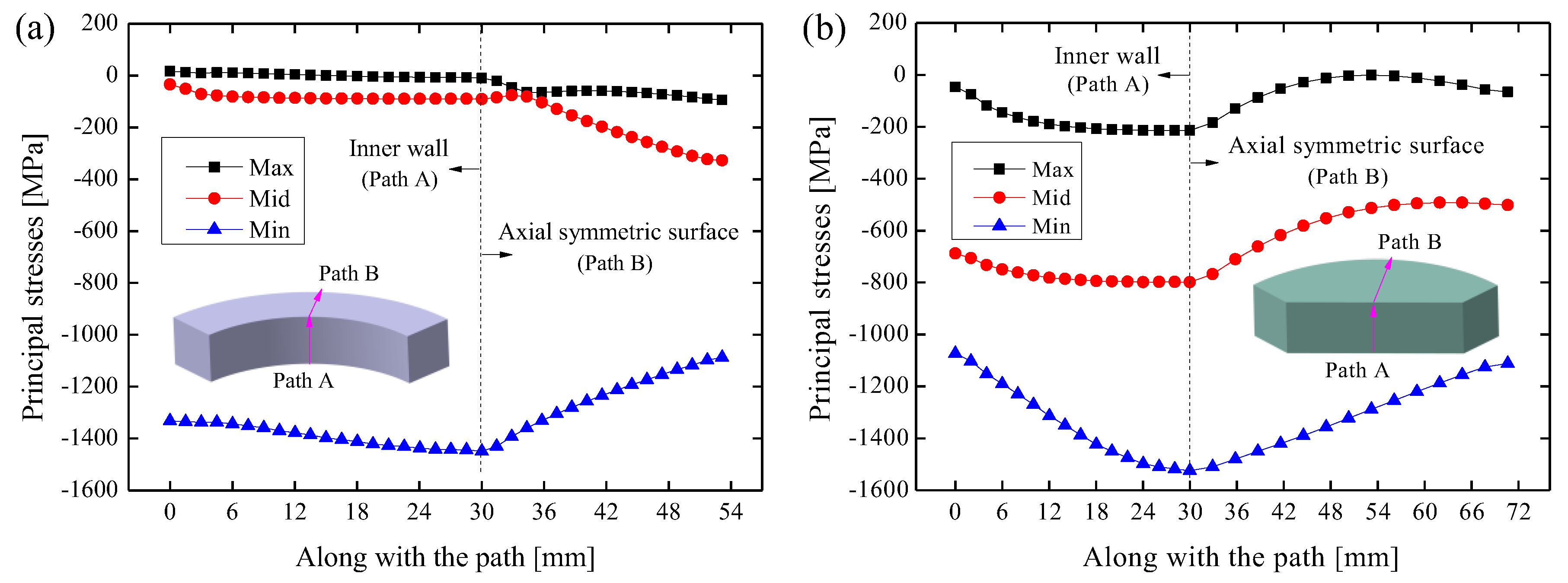


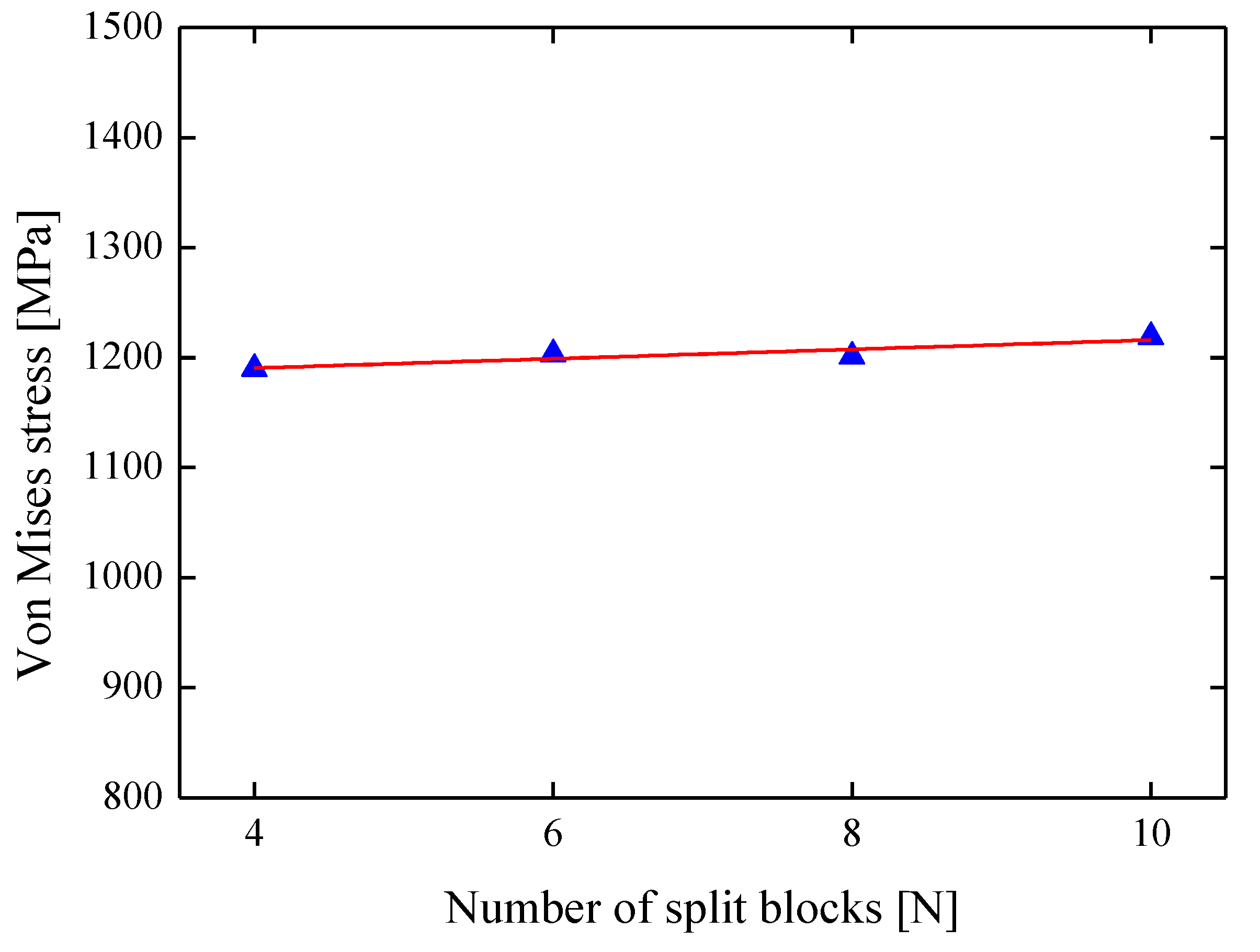
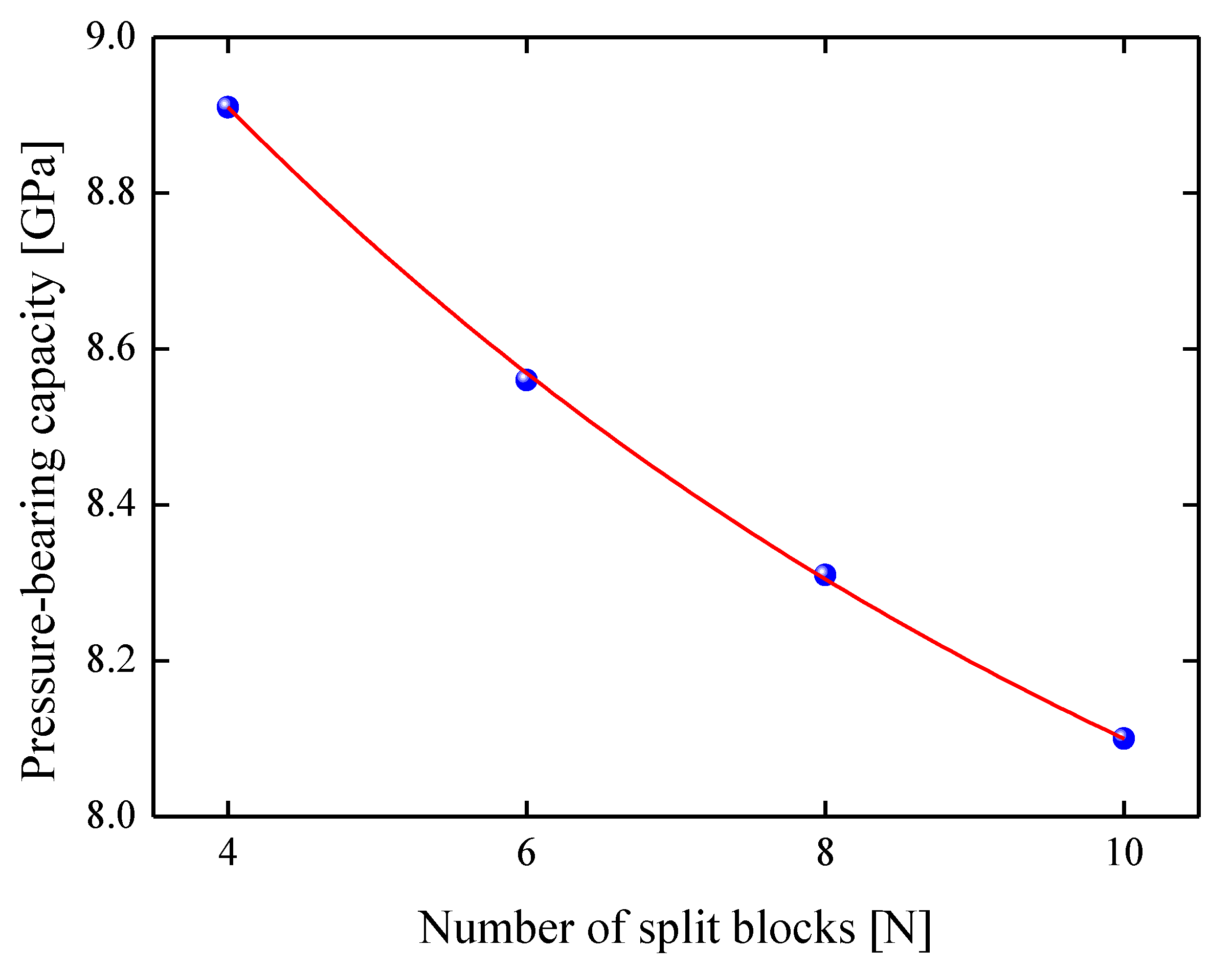

| Material | Density (g/cm3) | Young’s Modulus (GPa) | Poisson’s Ratio | Failure Strength (MPa) |
|---|---|---|---|---|
| Tungsten carbide | 14.6 | 578 | 0.21 | 6200 |
| Alloy steel | 7.83 | 210 | 0.29 | 1330 |
© 2018 by the authors. Licensee MDPI, Basel, Switzerland. This article is an open access article distributed under the terms and conditions of the Creative Commons Attribution (CC BY) license (http://creativecommons.org/licenses/by/4.0/).
Share and Cite
Yi, Z.; Fu, W.; Li, M.; Zhao, L.; Wang, L.; Li, R. Strength Analysis of a Novel High-Pressure Die with Double-Layered Split Structure. Metals 2018, 8, 606. https://doi.org/10.3390/met8080606
Yi Z, Fu W, Li M, Zhao L, Wang L, Li R. Strength Analysis of a Novel High-Pressure Die with Double-Layered Split Structure. Metals. 2018; 8(8):606. https://doi.org/10.3390/met8080606
Chicago/Turabian StyleYi, Zhuo, Wenzhi Fu, Mingzhe Li, Liang Zhao, Liyan Wang, and Rui Li. 2018. "Strength Analysis of a Novel High-Pressure Die with Double-Layered Split Structure" Metals 8, no. 8: 606. https://doi.org/10.3390/met8080606




